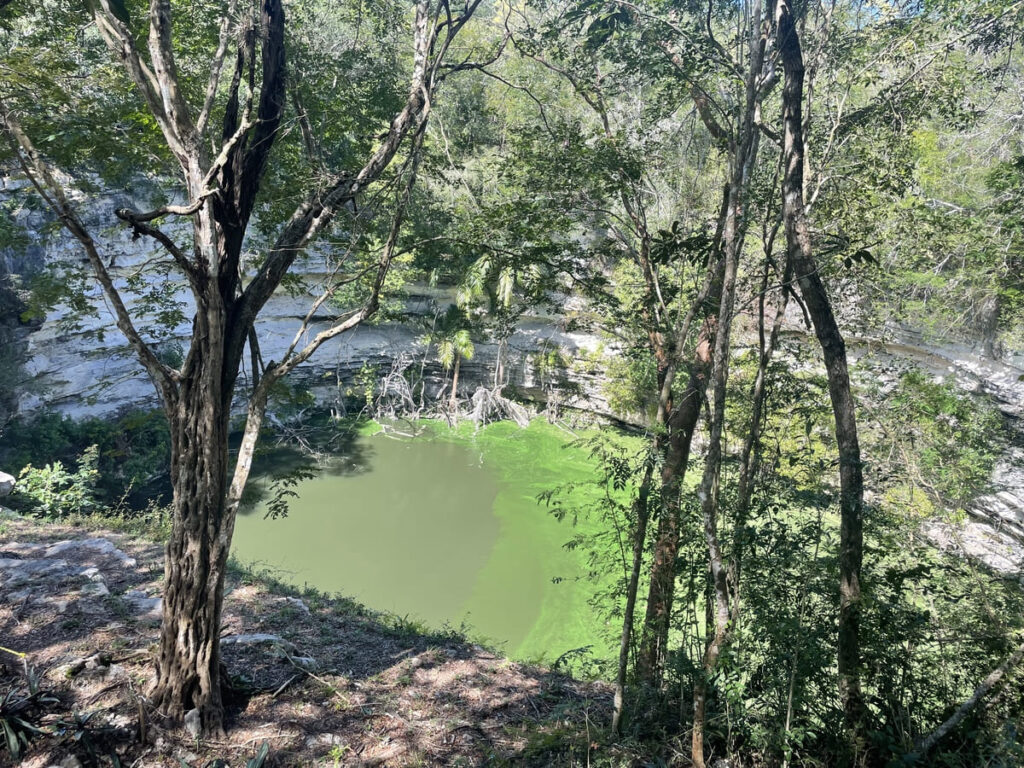During my time in Yucatan Mexico, I´ve experienced some of the richness of cenotes in this area. At first, I didn´t really understand the meaning of this term, I used to simply call them holes in the ground until some people from the hostel pointed out that I was talking about cenotes. Beyond being a popular tourist attraction, cenotes have a much deeper significance. As our guide in Chichen-Itza explained to us, they hold clues to the history of our planet, including the mystery of the dinosaur extinction. In this blog post, I want to take you on a journey through time to understand the connection between cenotes and dinosaur extinction.
What are Cenotes?
If you have never visited Mexico, cenotes may be unfamiliar to you. To begin with, Cenote derived from the Mayan word tz´onot, which stands for “natural well of water” (López, 2008). The term refers to a water-filled underground with “an opening to the outside” (López, 2008). In other words, cenotes are natural sinkholes in the ground. 1
Fot the Mayans, who migrated to Yucatan around 2500 B.C. 2, Cenotes were an important water source. They made them centres of their settlements. In addition, cenotes hat symbolic value for this culture. The ancient Mayans regarded these sinkholes as sacred sites for ceremonies such as rainmaking rituals.
Today, Cenotes are popular among tourists. Especially the ones with crystal-clear water. I have also visited two of these infamous sinkholes. Whether the water of the cenote is clear or not, depends on its structure. If there isn´t much water flow within the cenote, organic matter accumulates and the cenote becomes turbid. 1
The well-visited cenote in the picture below, is a collapse doline, a large ground opening with vertical walls. This cenote is only an example of the variety that awaits you in Yucatan, since there are over 2000 cenotes 3 in the Peninsula. Besides being pretty they provide important information about geological processes in this area. 1 I always find it exciting how you can draw conclusions about the past from rocks. I will go into more detail later.

The ecological worth of cenotes
Cenotes are important wetlands and are home to many different species, including amphibians, migrating birds and freshwater fish. Moreover, cenotes are often associated with mangroves, an ecosystem with high biodiversity. 3
The formation of Cenotes
Why are Cenotes particularly common in the Yucatan peninsula? Yucatan is a flat platform consisting of calcium carbonate (limestone). This platform popped up from the sea around 50 million years ago because of atmosphere and ocean cooling. 4
Over centuries, rainwater dissolved the calcium carbonate, causing a connection of underground caverns, rivers, and cenotes. As a result, Peninsula’s geography is strongly influenced by this network, making it a popular site for cave diving. 1 3
In the north, cenotes were formed not only by water impact but also by the Chicxulub asteroid, which resulted in the Ring of Cenotes. 3
The Dinosaur Extinction
Let´s remember the beginning of the post, where I promised to tell you about the link between cenotes and the dinosaur extinction. You’ve probably heard of the asteroid that was involved in the formation of cenotes in the north, without knowing it. Scientists assume that the Chicxulub asteroid also caused the extinction of the dinosaurs. 5
The extinction of the dinosaurs occurred around 66 million years ago. Although there are different theories for their disappearance, the asteroid impact at Chicxulub in Mexico is probably the most well-known. The asteroid left a crater of 180- to 200-km-diameter, releasing sulphate and carbonate gases from the underlying rock during the impact. The gases brought catastrophic environmental conditions such as acid rain, darkness, and global cooling. 5 These disastrous events are supposed to have wiped out the dinosaurs and with them 75% of all species on earth. Afterwards, biodiversity gradually recovered and new species found their way to earth. 6
If you are wondering how sulphates can cool the planet, check out my blog post about the environmental consequences of a super-volcano eruption.
Conclusion
In conclusion, Cenotes are natural sinkholes in the ground situated in Yucatan Peninsula. They are unique as a geological feature and formed through the dissolution and collapse of limestone (calcium carbonate). For the ancient Mayans, cenotes provided water and held symbolic values. Nowadays, they are popular among tourists, but also for endangered species such as amphibians, migrating birds and freshwater fish. To jump back to the beginning, were we asked about the link between cenotes and the dinosaur extinction? Scientists assume that the same asteroid that wiped out the dinosaurs also was involved in forming the Ring of Cenotes Yucatan´s north.
References:- Luis Alberto Martos López, 2008. Underwater Archaeological Exploration of the Mayan Cenotes. Museum International, 100-110.
- History, 2018. Yucatán. Available at: https://www.history.com/topics/latin-america/yucatan [Accessed on 18.03.2023].
- Adame M. F., Santini N. S., Torres-Talamante O. and Rogers K., 2021. Mangrove sinkholes (cenotes) of the Yucatan Peninsula, a global hotspot of carbon sequestration. Biology Letters, Volume 17, Issue 5.
- Berggren, W., 2023. Britannica Available at: https://www.britannica.com/science/Cenozoic-Era [Accessed on 18.03.2023].
- Schulte P. et al, 2010. The Chicxulub Asteroid Impact and Mass Extinction at the Cretaceous-Paleogene Boundary. Science, Volume 327, Issue 5970, 1214-1218.
- Pennisi, E., 2019. How life blossomed after the dinosaurs died. Available at: https://www.science.org/content/article/how-life-blossomed-after-dinosaurs-died [Accessed on 18.03.2023].

 To provide scientific knowledge on this site for free means a lot to me. However, researching and writing costs me a lot of time. Since I´m a student, financial support for my blog post helps me to maintain scientific quality.
To provide scientific knowledge on this site for free means a lot to me. However, researching and writing costs me a lot of time. Since I´m a student, financial support for my blog post helps me to maintain scientific quality.